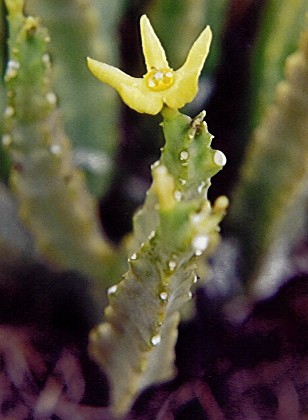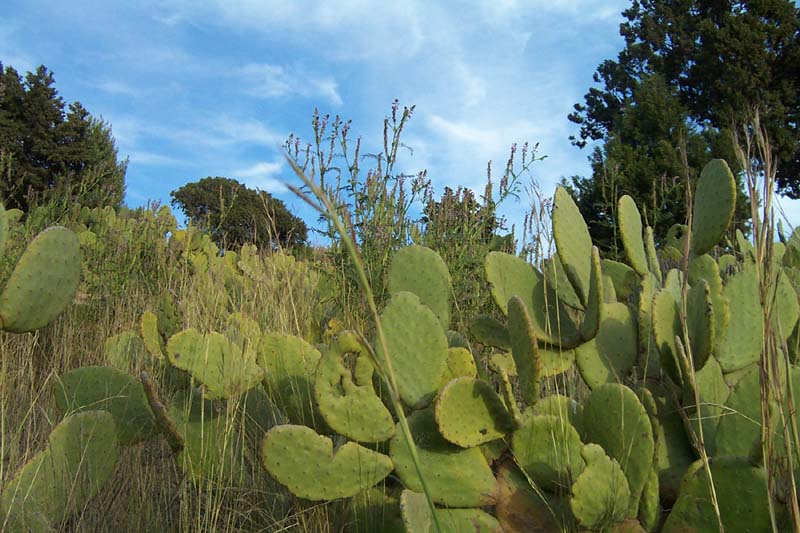Succulent plants are of great ecological significance particularly in arid and semi-arid parts of Saudi Arabia or the Arabian Peninsula in general. They store water in their stems, leaves or roots, a characteristic feature adopted by several plants to withstand high temperature and low precipitation. Succulent plants are usually seen in the eastern slops of southern Hijaz Mountains, along the Arabian Gulf and Red Sea coast, shallow depressions and dry lake beds containing high levels of dissolved minerals that are noxious to other plants. In Saudi Arabia, approximately, 290 species belonging to 23 families are generally recognized as succulent. Some of the families, representing succulent species are Aizoaceae, Aloaceae, Asclepiadaceae, Cactaceae, Chenopodiaceae, Crassulaceae, Dracaenaceae, Euphorbiaceae, Portulacaceae and Zygophyllaceae.
Some of succulent plants have ornamental value (Adenium arabicum, Duvalia spp., Huernia spp., Caralluma spp., Euphorbia spp.) while a few other species (e.g. Sansevieria- Dracaenaceae)are economically important in local fiber industry or are deeply associated with the culture of the country. In Saudi Arabia, Asclepiadaceae is the largest family with over 27 species followed by Chenopodiaceae and Aloeaceae with 24 species each, majority of which are seen in the northwestern and southwestern regions. Aloe is the largest succulent genus in Saudi Arabia, containing about 24 species. The most popular among them are Aloe vera var. officinalis, Aloe sabaea, etc.. Species such as Aloe armatissima Lavr. & Colle, Aloe porphyrostachys Lavr. & Colle., Aloe shadensis Lavr. & Colle. and Aloe sheilae Lavr. are endemic to Saudi Arabia.
Euphorbia species are generally regarded as poisonous and spiny, some of them are as tall as 5 meters. Genera such as Caralluma, Caudanthera, Borelluma, Duvalia, Heurnia etc. of Asclepiadaceae have 4-5-sided succulent stems and possess very attractive flowers seen either singly or in clusters.
Agavaceae contains only 2 genera, namely Dracaena and Sansevieria. The former (Dracaena ombet) is found in the high altitude areas while the latter, represented by two species (S. ehrenbergii and Sansevieria forskaliana) is usually seen in low lying areas. Members of Agavaceae are of considerable economic importance in the Arab World because of their fibrous leaves/stems which were widely used in making mats, baskets, hats, etc. All three species have a scattered distribution in the south western region. Cactaceae, a New World family, is represented in Saudi Arabia by two exotic species, Opuntia dellenii and O. ficus-indica. Both species are now invaded into large tracts of the vegetation-rich areas of south western mountains. Crassulaceae is a relatively small family in Saudi Arabia. All members (4 genera and 16 species) of this family in Saudi Arabia are leaf succulents and are seen among the high altitude areas of Hijaz Mountains. Umblicus spp. and Sedum spp. are moist loving plants, usually found among Pteridophytes.
Portulacaceae is represented by 2 genera and six species of annual or perennial herbs. Members of this family are characteristic of 2-phyllous floral involucre (sometimes considered as sepals) with scales or hairs at the leaf bases. The most prominent among them is the widely distributed, edible plant, Portulaca oleracea which is found in almost all semi aquatic habitats of Saudi Arabia. In Zygophyllaceae, two genera are succulent. Among these Nitraria retusa is reported from the eastern province while the genus Zygophyllum (Tetreana) with six species have a wider distribution, commonly seen in saline habitats.
Succulent species of Chenopodiaceae are also important in arid regions, some of which are extremely fleshy while a few genera, for example, Salicornia and Halocnemum have articulated stems with no leaves. In genera like Salsola, Haloxylon, etc the leaves are scale-like and are distributed in the arid regions or in the coastal and inland sabkhas (Salty areas).
AIZOACEAE
Aizoon hispanicum
Delosperma harazianum
Mesembryanthemum forsskalii
Mesembryanthemum nodiflorurn
Sesuvium sesuvioides
Sesuvium verrucosum
Trianthema crystalliną
Trianthema portulacastrum
Trianthema sheilae
Triantheina triquetra
Zaleya pentandra
ALOACEAE
Aloe abhaica
Aloe armatissima
Aloe brunneodentata
Aloe castellorum
Aloe cephalophora
Aloe edentata
Aloe fleurentiniorum
Aloe hijazensis
Aloe niebuhriana
Aloe officinalis
Aloe parvicapsula
Aloe parvicoma
Aloe porpyrostachys
Aloe pseudorubroviolacea
Aloe qaharensis
Aloe rivierei
Aloe rubroviolacea
Aloe sabaea
Aloe shadensis
Aloe sheilae
Aloe vacillans
Aloe vulcanica
Aloe woodii
Aloe yemenica
APOCYNACEAE
Adenium obesum
ASCLEPIADACEAE
Angolluma commutata ssp. sheilae
Angolluma deflersiana
Angolluma erernastrum
Angolluma wissmannii
Borealluma tuberculata
Caralluma subulata
Caudanthera sinaica
Caudanthera sinaica
ssp.
baradii
Crenulluma petraea
Cryptolluma edulis
Cylindrilluma solenophora
Desmidorchis penicillatus
Desmidorchis retrospiciens
Duvalia sulcata
Duvalia sulcata
var.
semi-nuda
Duvalia velutina
Huernia arabica
Huernia
sp. nov. aff.
boleana
Huernia laevis
Huernia
sp. aff.
lodarensis
Huernia saudi-arabica
Monolluma quadrangula
Rhytidocaulon macrolobum
Rhytidocaulon macrolobum
ssp.
minimum
Rhytidocaulon sheilae
Sulcolluma shadhbana
Sulcolluma shadhbana var. barhana
CACTACEAE
Opuntia ficus-indica
Opuntia dillenii
CARYOPHYLLACEAE
Sphaerocoma aucheri
CHENOPODIACEAE
Agathophora alopecuroides
Anabasis setifera
Arthrocnemum macrostachyum
Bienertia cycloptera
Halocharis sulphurea
Halocnemum strobilaceum
Halopeplis perfoliata
Salicornia europaea
Salsola arabica
Salsola cyclophylla
Salsola drummondii
Salsola imbricata
Salsola jordanicola
Salsala kali
Salsola lachnantha
Salsola schweinfurthii
Seidlitzia rosmarinus
Sevada schimperi
Suaeda aegyptiaca
Suaeda maritima
Suaeda monoica
Suaeda vermiculata
Traganum nudatum
Compositae
Kleinia odora
Kleinia pendula
CRASSULACEAE
Crassula alata
Crassula alata
ssp.
pharnaceoides
Crassula alba
Crassula schimperi
Crassula tillaea
Kalanchoe alternans
Kalanchoe citrina
Kalanchoe crenata
Kalanchoe deficiens
var.
glabra
Kalanchoe glaucescens
Kalanchoe laciniata
Kalanchoe lanceolata
Sedum caespitosum
Sedum hispanicum
Umbilicus horizontalis
Umbilicus rupestris
CYNOMORIACEAE
Cynomorium coccineum
DRACAENACEAE
Sansevieria ehrenbergii
Sansevieria forskaliana
EUPHORBIACEAE
Euphorbia agowensis
Euphorbia ammak
Euphorbia balsamifera ssp. adenensis
Euphorbia cactus
Euphorbia fractiflexa
Euphorbia fruticosa
Euphorbia inarticulata
Euphorbia milii
Euphorbia parciramulosa
Euphorbia schimperi
Euphorbia triaculeata
GENTIANACEAE
Sebaea
sp.
Swertia polynectaria
Swertia woodii
HYDNORACEAE
Hydnora johannis
ORCHIDACEAE
Eulophia petersii
OROBANCHACEAE
Cistanche phelypaea
Cistanche tubulosa
Cistanche tubulosa var. albiflora
Cistanche violacea
Orobanche abyssinica
Orobanche aegyptiaca
Orobanche cernua var. cernua
Orobanche cernua var. desertorum
Orobanche cernua var. latebracteata
Orobanche hypertomentosa
Orobanche minor
Orobanche oxyloba var. oxyloba
Orobanche pubescens
Orobanche sp. aff. purpurea
Orobanche ramosa
PASSIFLORACEAE
Adenia venenata
PLUMBAGINACEAE
Limonium axillare
Limonium carnosum
Limonium cylindrifolium
POLYGONACEAE
Rumex vesicarius
PORTULACACEAE
Portulaca grandiflora
Portulaca kermesina
Portulaca oleracea
Portulaca pilosa
Portulaca quadrifida
TAMARICACEAE
Reaumuria hirtella
VITACEAE
Cissus quadrangularis
Cissus rotundifolius
ZYGOPHYLLACEAE
Nitraria retusa
Zygophyllum album
Zygophyllum boulosii
Zygophyllum coccineum
Zygophyllum decumbens
Zygophyllum hamiense
Zygophyllum mandavillei
Zygophyllum migahidii
Zygophyllum qatarense
Zygophyllum simplex

